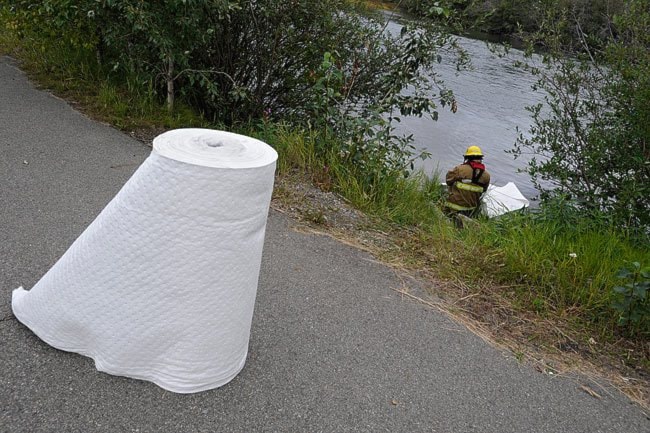A liquid that was spilling into the Yukon River this week near Boston Pizza remains a mystery.
“We don’t know what it is, where it’s coming from or how much spilled,” said Environment spokesperson Nancy Campbell on Thursday.
Environment Yukon also doesn’t know what its impact will be on the salmon swimming up the Yukon River to spawn.
When there’s a spill in fish-bearing waters, Environment Canada takes the lead.
But Environment Canada’s Yukon emergency planning and spill co-ordinator position has been vacant for roughly 18 months.
“It’s an issue,” said an Environment Canada staffer at the Yukon office, who refused to talk on the record.
“You need to call Ottawa’s media relations,” said the staffer.
On Wednesday, after repeated calls from the News - and before washing its hands of the spill - Environment Canada issued an email:
“It has yet to be confirmed, but the source of the leak may be the result of ongoing work at a decommissioned gas station located approximately 150 metres away from the spill site in the Yukon River,” wrote Elizabeth Graca, Environment Canada’s acting manager for environmental emergencies.
“When work crews stopped working at the gas station site, the leak also stopped into the river.”
The gas station in question is now owned by North of 60.
But it used to be a Shell station, said Campbell.
North of 60 has been decommissioning the gas station, she added.
Environment Yukon has “guys monitoring the spill,” she said.
And there are booms in place to contain it.
“The material is thought to be diesel fuel, based on the odour at the time of the release,” wrote Graca in her original email.
“No estimates are available regarding the volume of diesel that was leaked.”
The impact of the spill is unknown, added Graca. “The material entered the fish-bearing waters of the Yukon River and was originally reported as a ‘heavy sheen.’
“Environment Canada will be making an assessment of the nature and cause of the incident ... after having obtained and reviewed the facts in the matter they will proceed with any necessary enforcement action in keeping with Environment Canada’s Compliance and Enforcement Policy for the Habitat Protection and Pollution Prevention Provisions of the Fisheries Act.”
But the day after promising to deal with the spill and take enforcement action, Environment Canada dropped the matter.
It deputized the Yukon’s Department of Environment.
“Through a mutual agreement between Environment Canada and Environment Yukon, Environment Yukon has taken the lead on this incident,” wrote federal spokesman Henry Lau in an email on Thursday.
Lau refused to respond to questions about the Environment Canada’s vacant spill co-ordinator position in the Yukon.
And Environment Canada’s Yukon staffers said they were not allowed to talk about it, “especially given the recent events in the news”- meaning the Harper government’s recent decision to cut another 10 per cent of the department’s staff.
Meanwhile, the mysterious substance continued to create “a heavy sheen” on the Yukon River.
“It seems to have stopped now,” said Campbell on Thursday.
The Yukon’s Environment Department is analyzing the substance, she said.
“We suspect hydrocarbons are involved.”
The cost of the cleanup is still unknown, added Campbell.
And it’s still unclear who will pay for it, she said.
“There’s a mantra, the polluter pays,” said Campbell.
“But who owns it now may not be the people who put the pollutants into play.”
This was the problem with the Marwell tar pits, she said, referencing a huge petroleum sinkhole close to Two Mile Hill that actually killed a man in 1958.
Surrounded by a fence and covered in places with a tarp, the pit was left by the Imperial Oil company after it dismantled a nearby oil refinery in 1947.
The site has been on a list of federal contaminated sites for decades.
Its proximity to the Yukon River has generated many worries, but little action.
The Yukon government has been asking Ottawa to clean up the site since at least 1994.
But, to date, there has been little action.
Now, with its Yukon emergency planning and spill prevention co-ordinator position remaining vacant, Ottawa appears to be washing its hands of territorial issues.
“We can’t talk to you about it,” said the local Environment Canada staffer.
“That’s the new name of the game.”
Contact Genesee Keevil at
gkeevil@yukon-news.com.
